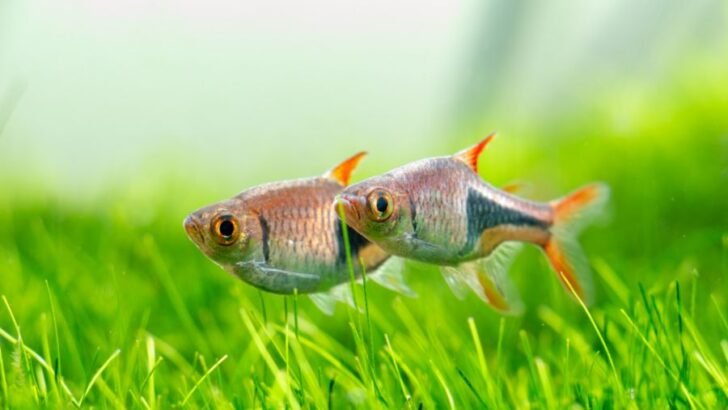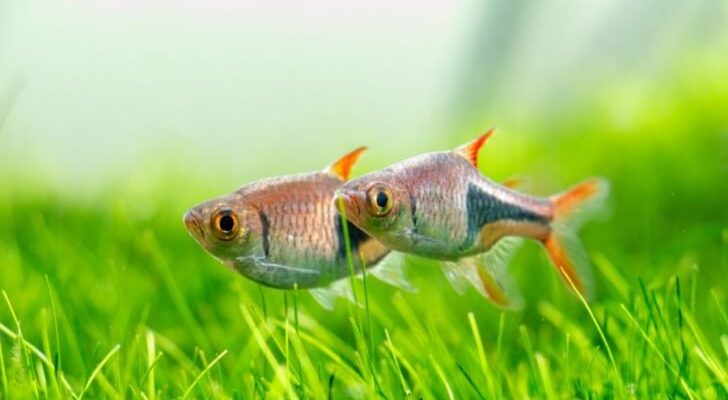
Before you roll up your sleeves and dive into the breeding process, it’s good to know what you’re getting into. Breeding Rasbora isn’t just about tossing a male and female together. It requires some preparation, patience, and understanding of their natural behavior. Let’s explore how you can create the perfect environment to encourage these fish to spawn and raise their little ones.
Understanding Rasbora Species
When we talk about Rasbora, we’re often referring to several species, each with unique traits. The most popular species for breeding at home include the Harlequin Rasbora and Galaxy Rasbora. Both are small, typically growing to about 1.5 to 2 inches long, making them easy to fit into various aquarium setups.
The Harlequin Rasbora is known for its striking orange and black coloration, which resembles a patterned harlequin mask. Meanwhile, the Galaxy Rasbora, also called the Celestial Pearl Danio, boasts a more subtle beauty with its shimmering blue spots against a darker body. Knowing which species you’re working with can greatly impact your breeding success, as their requirements may slightly differ.
Not only do these species have different appearances, but their breeding rituals can also vary. This means it’s essential to do a bit of research on the specific type of Rasbora you want to breed before setting up your breeding tank. Each fish has its little quirks, and the more you know about them, the better you’ll be at creating a suitable environment.
Setting Up a Breeding Tank
Now that you have a handle on the species, let’s talk about setting up the perfect breeding tank. Think of this tank as a cozy little home where your Rasboras can feel safe and happy. A well-planned breeding tank doesn’t just make the fish comfortable; it also encourages them to breed.
You’ll want to start with a tank that’s at least 10 gallons. This gives your fish plenty of space to swim around. Here’s a checklist of things you’ll need to create a suitable environment:
- Soft substrate: Fine gravel or sand works well, as it mimics their natural habitat.
- Plants: Live plants like Java moss or floating plants provide hiding spots and a place for eggs to rest away from hungry fish.
- Water quality: Aim for a pH of 6.0 to 7.5 and a temperature between 75°F and 80°F. Make sure to cycle the tank before introducing any fish.
It’s essential to keep the tank well-filtered but without strong currents, as Rasboras prefer calm waters. Adding a sponge filter can help keep the water clean while providing a gentle flow. After setting everything up, give your tank a few days to stabilize before introducing your breeding pair.
Choosing Breeding Pairs
Choosing the right breeding pair is crucial to the success of your breeding efforts. Typically, a good ratio is one male for every two females. This way, the males can show off their colors and courtship displays without overwhelming the females.
You might be wondering how to identify males from females. Male Rasboras tend to be smaller and have more vibrant colors, especially during breeding season, while females are usually rounder with a fuller belly when they’re full of eggs. By observing their behavior, you’ll quickly notice the males flashing their colors and performing little dances to attract the females.
Once you have selected the right pair, give them time to adjust to the breeding tank. Keeping the lights dim can help reduce stress and mimic their natural spawning conditions. After a few days, you should start to see some courting behaviors.
Feeding Your Rasbora Before Breeding
To promote breeding, it’s important to provide a nutritious diet leading up to the spawning. Think of it like getting ready for a big event; you want your fish to be at their best. A varied diet will not only keep your Rasboras healthy but also encourage them to breed.
Start by feeding them high-quality flake foods but mix in some live or frozen foods as well. Options like brine shrimp or daphnia are excellent choices. These protein-rich foods can help boost the females’ egg production while keeping the males lively and vibrant.
You might want to feed them several small meals throughout the day. This can help simulate a natural environment where food sources are readily available. Keep an eye on the tank during feeding times; if the fish are eagerly eating, that’s a good sign they’re healthy and ready to breed.
Encouraging Spawning
After your Rasboras have settled into their new home and have been well-fed, it’s time to encourage spawning. The ideal conditions for spawning include slightly cooler water temperatures, often around 72°F. This can mimic a rainy season in their natural habitat, signaling that it’s time to reproduce.
To trigger spawning, consider performing a small water change with slightly cooler water. This not only refreshes the tank but can also encourage the fish to start their breeding process. You may notice the males chasing the females and displaying their colors more prominently.
Once the pair starts spawning, you’ll see the female laying eggs on the spawning surface, which can be leaves or the substrate. The male will then fertilize these eggs. It’s important to remove the adult fish after spawning, as they might eat the eggs if given the chance. This way, you can ensure more fry survive to adulthood.
Raising Rasbora Fry
After a few days, you should see tiny fry swimming around if the eggs were fertilized. This is an exciting moment! But raising fry can be a bit challenging. The fry are incredibly small and need specialized care.
Start by feeding the fry infusoria or liquid fry food specially formulated for tiny fish. You can also use finely crushed flake food, but be sure it’s tiny enough for them to eat. Keep the water clean by doing regular water changes, but be careful not to disturb them too much during this fragile stage.
As the fry grow, you can gradually introduce larger foods. They’ll start to develop more color, and you can even begin to differentiate between males and females as they mature. Raising Rasbora fry is a labor of love, but seeing them grow and thrive under your care is incredibly rewarding.
Common Challenges and Solutions
Like anything, breeding Rasbora isn’t always smooth sailing. You might face some challenges along the way. One common issue is poor egg fertilization. This can happen if either the male or female isn’t healthy or if conditions in the tank aren’t just right.
Another challenge could be the fry not surviving past the first few days. This can stem from eggs being eaten by the parents or unsuitable water conditions. Ensure that you have a proper, well-maintained tank, and take steps to protect the eggs.
If you encounter issues, don’t get discouraged. Use these moments as learning experiences. Adjust your feeding routine, double-check water parameters, and look into better tank setups. Each experience will help refine your skills as a Rasbora breeder.
Final Thoughts on Breeding Rasbora
Breeding Rasbora at home can be a truly fulfilling experience. It combines the joy of nurturing with the beauty of watching life unfold in your aquarium. Remember, patience is key! You’re cultivating a tiny ecosystem, and it’ll take time to learn what works best for you and your fish.
With the right setup, careful attention, and a little love, you’ll be on your way to successfully breeding these beautiful fish. Whether you end up with a tank full of adorable fry or just enjoy the process of learning, the journey of breeding Rasbora is worth every moment spent. So gear up, enjoy yourself, and get ready for a colorful adventure in your aquarium!

